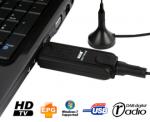Sale on Special Edition USB HD DVB-T Tuner

DVB-T is an abbreviation for "Digital Video Broadcasting — Terrestrial"; it is the DVB European-based consortium standard for the broadcast transmission of digital terrestrial television that was first published in 1997[1] and first broadcast in the UK in 1998.[1] This system transmits compressed digital audio, digital video and other data in an MPEG transport stream, using coded orthogonal frequency-division multiplexing (COFDM or OFDM) modulation. Basics[edit] Rather than carrying one data carrier on a single radio frequency (RF) channel, COFDM works by splitting the digital data stream into a large number of slower digital streams, each of which digitally modulate a set of closely spaced adjacent sub-carrier frequencies. In the case of DVB-T, there are two choices for the number of carriers known as 2K-mode or 8K-mode. These are actually 1,705 or 6,817 sub-carriers that are approximately 4 kHz or 1 kHz apart. DVB-T offers three different modulation schemes (QPSK, 16QAM, 64QAM). DVB-T has been adopted or proposed for digital television broadcasting by many countries (see map), using mainly VHF 7 MHz and UHF 8 MHz channels whereas Taiwan, Colombia, Panama, Trinidad and Tobago and the Philippines use 6 MHz channels. Examples include the UK's Freeview.